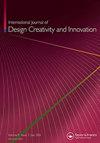测试大量设计师的思维表现:类比距离的影响
IF 2.5
Q4 ENGINEERING, MANUFACTURING
International Journal of Design Creativity and Innovation
Pub Date : 2019-05-25
DOI:10.1080/21650349.2019.1618736
引用次数: 17
摘要
摘要本文报道了一项实验,旨在提供新的证据来强化工程设计文献中关于类比距离对设计师思维表现影响的矛盾结论。该实验涉及84名机械工程专业的研究生,他们在工程设计方面具有典型的能力,但在基于类比的思想生成方面没有任何特定的技能。受试者接受了三种不同的治疗(近场、中场和远场模拟),并将其设计性能与对照组进行了比较。观察结果证实,没有受过类比设计专门训练的设计师可以从与目标系统具有相同(子)功能和背景的灵感来源中受益,因为与接触更远类比的受试者相比,他们的想法生成过程会产生更高新颖性和质量的想法。观察结果还表明,对设计空间的探索受到了积极的影响。本文章由计算机程序翻译,如有差异,请以英文原文为准。
Testing ideation performance on a large set of designers: effects of analogical distance
ABSTRACT This paper reports an experiment that aims at providing new evidence to reinforce contradictory conclusions, as available in engineering design literature, on the effect of analogical distance on ideation performance of designers. The experiment involved 84 graduate students in Mechanical Engineering, with typical competencies on engineering design, but without any specific skill on analogy-based idea generation. The subjects were exposed to three different treatments (near-, medium-, far-field analogies) whose design performance has been compared to a control group. The observation confirms that designers not specifically trained in designing-by-analogy get benefit from sources of inspiration that share the same (sub-)functions and context of the target system, as their idea generation process lead to ideas having higher novelty and quality compared to the outcomes of subjects exposed to more distant analogies. The observed results also show that the exploration of the design space gets positively affected.
求助全文
通过发布文献求助,成功后即可免费获取论文全文。
去求助
来源期刊

International Journal of Design Creativity and Innovation
ENGINEERING, MANUFACTURING-
CiteScore
3.80
自引率
27.80%
发文量
15
期刊介绍:
The International Journal of Design Creativity and Innovation is an international publication that provides a forum for discussing the nature and potential of creativity and innovation in design from both theoretical and practical perspectives. Design creativity and innovation is truly an interdisciplinary academic research field that will interest and stimulate researchers of engineering design, industrial design, architecture, art, and similar areas. The journal aims to not only promote existing research disciplines but also pioneer a new one that lies in the intermediate area between the domains of systems engineering, information technology, computer science, social science, artificial intelligence, cognitive science, psychology, philosophy, linguistics, and related fields. The journal covers, but is not restricted to, the following topics: ·Theories on Design Creativity and Innovation ·Cognition of Design Creativity ·Innovative Process ·Inventive Process ·Analogical Reasoning for Design Creativity and Innovation ·Design Synthesis ·Method and Tools for Design Creativity and Innovation ·Representation of Design Creativity and Innovation ·Education for Design Creativity and Innovation ·Concept Generation and Inspiration.
 求助内容:
求助内容: 应助结果提醒方式:
应助结果提醒方式:


